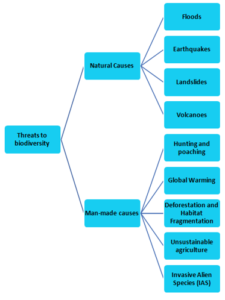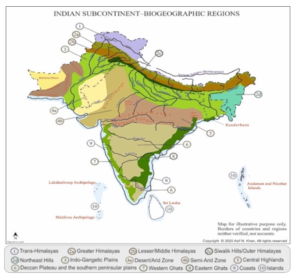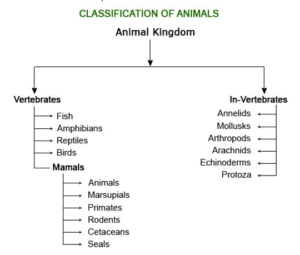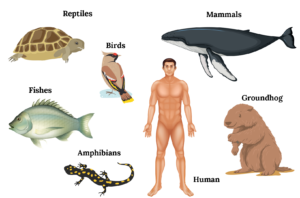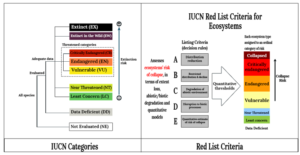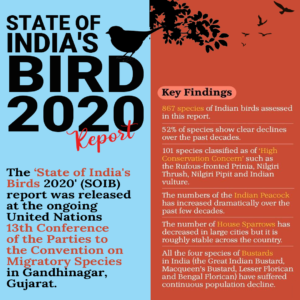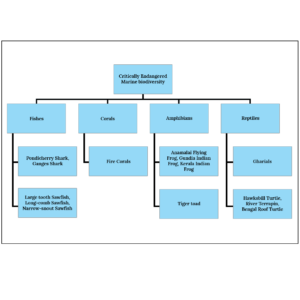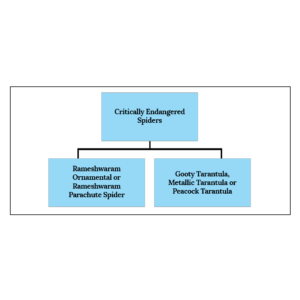Contents
This page is a part of our environment guide initiative. Read complete material here.
Biodiversity [pdf]
Biodiversity is a term used to describe the enormous variety of life on Earth. It is a measure of variation at the genetic, species and ecosystem level. Terrestrial biodiversity is usually greater near the equator, which is the result of the warm climate and high primary productivity. Mountains have high range of species at the low altitude as they can support larger number of species due to climatic condition.
There are three levels of biodiversity:
- Genetic diversity– It is concerned with the variability of genes within a particular species. Genetic diversity allows species to adapt to changing environments and survive drastic changes. This ensures survival of the population.
- Species diversity– It refers to the variety of living organisms on Earth.
- Ecosystem diversity– It refers to different types of habitats like grasslands, desert, mangroves etc.
Biodiversity is measured using species richness. Species richness is the number of different species represented in an ecological community, landscape or region.
- Alpha diversity– It refers to diversity within a particular area or ecosystem.
- Beta diversity– It is a comparison of diversity between ecosystems.
- Gamma diversity– It is a measure of overall diversity for the different ecosystems within a region.
As per World Wildlife Fund’s (WWF) Living Planet Report, species extinction rate is 100-1000 times higher than a few hundred years ago. There are several constrains in biodiversity conservation like:
- Low priority for conservation in policies.
- Exploitation of biodiversity for monetary gains.
- Limited knowledge regarding biodiversity and its importance.
- Unplanned urbanization resulting in destruction of wetlands, deforestation etc.
Considering the threats to biodiversity, there are two modes of conservation of the same:
- In-situ conservation– It aims to enable biodiversity to maintain itself within the natural habitats in which it is found. E.g., National parks, sanctuaries, Biosphere reserves, reserved forests and protected forests.
- Ex-situ conservation– It aims at conserving biodiversity outside the areas where they naturally occur. E.g., Seed banks and botanical gardens.
Reintroduction of Gangetic gharial in Chambal river flowing through Uttar Pradesh, Rajasthan and Madhya Pradesh where it had become extinct is an example of Ex-situ conservation.
| A botanical garden or botanic garden is a garden dedicated to the collection, cultivation, preservation and display of a wide range of plants labelled with their botanical names. It is an ex-situ mode of conservation. | Zoo is an establishment, whether stationary or mobile, where captive animals are kept for exhibition to the public and includes a circus and rescue centers but does not include an establishment of a licensed dealer in captive animals. It is an ex-situ mode of conservation. |
5.1 Indian Biodiversity
With just 2.4% of the land area, India accounts for nearly 7% of the recorded species. The varied climatic, edaphic and topographic conditions have resulted in a wide array of ecosystems and habitats in India with enormous biodiversity.
5.1.1 Landscape Biodiversity
A landscape is a “mosaic of heterogeneous landforms, vegetation types and land uses.”
- Realms: Realm is a continent or subcontinent sized area with unifying feature of geography, flora and fauna.
The Indian region is composed of two realms-
- The Himalayan region represented by Palearctic Realm.
- Rest of subcontinent represented by Malayan Realm.
- Biomes: A biome is a collection of plants and animals that have common characteristics for the environment they exist in. They can be found over a range of continents. The five biomes of India are Tropical Humid Forests, Tropical Dry or Deciduous Forests, Warm Deserts or Semi-deserts, Coniferous Forests and Alpine Meadows.
- Biogeographic Zones: Biogeography deals with the geographical distribution of plants and animals. The Himalayan range is very rich in species diversity due to confluence of different bio-geographical zones.
Picture Credits: Wikipedia
- Biogeographic provinces– It is an Eco systematic or biotic subdivision of realms.
| Sl. No | Biogeographic zones | Biogeographic provinces |
| 1 | Trans Himalaya | 1. Himalayan-Ladakh Mountains 2. Himalaya-Tibetan Plateau 3. Trans-Himalaya Sikkim |
| 2 | The Himalaya | 1. Himalaya-North West Himalaya 2. Himalaya- West Himalaya 3. Himalaya- Central Himalaya 4. Himalaya- East Himalaya |
| 3 | The Indian Desert | 1. Desert- Thar 2. Desert- Kutch |
| 4 | The Semi-Arid | 1. Semi- Arid- Punjab Plains 2. Semi- Arid- Gujarat Rajputana |
| 5 | The Western Ghats | 1. Western Ghats- Malabar Plains 2. Western Ghats- Western Ghats Mountains |
| 6 | The Deccan Peninsula | 1. Deccan Peninsular- Central Highlands 2. Deccan Peninsular- Chhota Nagpur 3. Deccan Peninsular- Eastern highlands 4. Deccan Peninsular- Central Plateau 5. Deccan Peninsular- Deccan South |
| 7 | The Gangetic Plains | 1. Gangetic Plain- Upper Gangetic Plains 2. Gangetic Plains- Lower Gangetic Plains |
| 8 | The Coasts | 1. Coasts- West Coast 2. Coasts- East Coast 3. Coasts- Lakshadweep |
| 9 | Northeast India | 1. North- East- Brahmaputra valley 2. North- East- North East hills |
| 10 | Islands | 1. Andaman and Nicobars |
5.1.2 Fauna
India accounts for about 6.45% of the faunal species known world-wide.
- Vertebrates: These are animals with backbones and spinal columns.
Basic facts:
1. Fishes and Reptiles are cold-blooded.
2. Amphibians are cold-blooded animals. They live on both land and water and breathe with lungs and gills.
3. Birds and Mammals are warm-blooded.
- In-vertebrates: These animals do not have backbones. More than 98% animal species in the world are invertebrates.
1. Annelids
a. Their bodies are divided into segments
b. They do not have limbs
c. E.g., earthworm
2. Mollusks
a. They have a soft, skin like organ covered with a hard shell on the outside
b. E.g., octopus, squid, oyster
3. Echinoderms
a. Their bodies are covered in spikes or spine
b. They live in water
c. E.g., sea star, sea urchin
4. Protozoa
a. They are the smallest of all animals
b. Protozoa are simple, single celled animals
c. E.g., Amoeba, flagellates
5. Arthropods
a. They have limbs with joints that allow them to move
b. They also have an exoskeleton
c. Crustaceans, insects and arachnids are examples of arthropods
6. Crustaceans
a. They have a hard external shell protecting their body
b. E.g., crab, lobster
7. Insects
a. They consist of 3 body parts and 6 legs and an antenna
b. E.g., beetle, butterfly, bee
8. Arachnids
a. They have 2 body parts and 4 pair of legs
b. They do not have an antenna
c. E.g., spider, scorpions, tick and mites
5.1.3 Flora
India represents about 11% of the world’s known floral diversity.
The National Gene Bank at National Bureau of Plant Genetic Resources (NBPGR), New Delhi; is the nodal organization in India for the management of plant genetic resources.
1. Himalayan mountain system:
a. Flora includes evergreen and semi-evergreen forests like rhododendrons, oak, pines, junipers, lichens, and mosses.
2. Peninsular- Indian sub-region: It includes peninsular India as well as the desert region of Rajasthan (Thar desert).
a. Peninsular India has tropical moist deciduous to tropical dry deciduous and scrub vegetation like Sal in northern regions, teak in southern regions.
b. Western ghats have evergreen vegetation. Threatened with deforestation, unchecked urbanization and invasive species, Gadgil Committee and Kasturirangan Committee were formed to recommend sustainable development of Western Ghats region.
c. Indian desert of Rajasthan has flora like cacti and other succulents.
3. Tropical rain forest regions: They are distributed in the Western Ghat region and north-east India.
a. Evergreen vegetation like ebony trees is found here. Epiphytes and orchids are also found in this region. Stratification in rain forests is very distinct with multiple horizontal layers of trees.
4. Andaman and Nicobar Islands:
a. Tropical rainforests species are found in this region like Terminalia.
Insectivorous plants specialize in trapping insects. They have several attractions to lure insects like bright colours and sweet secretions. They hunt for insects despite having normal roots as they are usually found in nutrient poor soils. As a result, they have to hunt in order to replenish themselves.
Some of the insectivorous plants found in India are Drosera/Sundew, Aldrovanda/Pitcher plants, Nepenthes, Utricularia/Bladderworts and Pinguicula/Butterworts. Insectivorous plants have great medicinal properties like treating cholera, urinary tract infections, blisters. Some are also capable of curdling milk.
| Pointers for prelims: 1. Mycorrhizae are symbiotic relationships that form between fungi and plants. The fungi colonize the root system of a host plant, providing increased water and nutrient absorption capabilities while the plant provides the fungus with carbohydrates formed from photosynthesis. 2. Sandal tree is a partial root-parasite, meaning that while it manufactures its own food, it also depends upon the host like other partial parasites for water and mineral nutrients. |
| Basic facts: 1. Effect of Intensity of light on the growth of plants a. High light intensity favors plant growth while low intensity retards growth, flowering and fruiting. 2. Frost can lead to killing of young plants due to damage to cells and formation of canker. 3. Snow results in mechanical bending of trees. However, it can also act as a blanket and prevent further drop in temperature, thus protecting seedlings from excessive cold and frost. 4. Excessive temperature disrupts the balance between respiration and photosynthesis, thereby causing depletion on food. It also increases susceptibility to bacterial and fungal attack. Further, there is desiccation of plant tissues and loss of moisture. 5. Die back phenomenon in trees like Sal, wherein there is progressive dying usually backwards from the tip of any portion of plant. Reason for this may include frost, drought, grazing, dense over-head canopy etc. |
are species whose introduction and/or spread outside their natural past or present distribution threatens biological diversity.
Some invasive fauna found in India are crazy ant, giant African snail, myna, goldfish and pigeon. Likewise, invasive flora of India includes Prosopis juliflora, water hyacinth, lantana camara, palmyra/toddy palm, black mimosa, and black wattle.
important medicinal plants of India are as follows:
1. Kuth is used as an anti-inflammatory drug as well as making perfumes.
2. Ladies Slipper Orchid is used to treat insomnia/anxiety.
3. Sarpagandha is used for treating various central nervous system disorders.
5.1.4 IUCN Red Data Book
IUCN Red Data Book contains the complete list of threatened species, including both plants and animals. The pink pages in this book include the critically endangered species. Green pages are used for species that were formerly endangered but have now recovered to a point where they are no longer threatened.
Picture Credits: IUCN
is a science-based network of more than 7500 volunteer experts from almost every country of the world.
5.1.5 Schedule Animals of Wildlife Protection Act 1972 (WPA)
Wildlife Protection Act consists of 6 schedule lists, which give varying degrees of protection. Poaching, smuggling and illegal trade of animals listed Schedule 1 to Schedule 4 are prohibited.
- Schedule 1 and part II of Schedule 2
- Animals listed under these have absolute protection.
- Examples of animals listed in Schedule 1 include lion tailed macaque, great Indian bustard, black buck, rhinoceros, dugong etc.
- Animals under Schedule 2 are dhole, flying squirrel etc.
- Schedule 3 and Schedule 4
- These animals are also protected but the penalties for offenses against them are lower.
- Schedule 3 animals include hyena, nilgai, barking deer, hog deer etc.
- Schedule 4 animals include vultures etc.
- Schedule 5
- Animals under Schedule 5 are called “vermin” and can be hunted.
- Mice, rat, common crow and flying fox are few examples
- Schedule 6
- Cultivation, collection, extraction and trade of plants and its derivatives listed in Schedule 6 are prohibited.
- Plants under this include Red Vanda, Blue Vanda, Kuth, Pitcher plant, Laddies Slipper Orchid and Beddomes Cycad
| Few important animals listed in Schedule 1 to 4 of WPA, 1972 | |||
| Sl. No | Name | Category | Range |
| 1 | Binturong | Vulnerable | Sikkim |
| 2 | Brow Antlered Deer/Sangai | Endangered | Keibul Lamjao National Park, Manipur |
| 3 | Swamp Deer | Vulnerable | Wide distribution |
| 3 | Cheetah | Vulnerable (Asiatic Cheetah is critically endangered and found in Iran only) | Extinct in India |
| 4 | Chinese Pangolin Indian Pangolin | Critically Endangered Endangered | Himalayan foothills |
| 5 | Clouded Leopard | Vulnerable | Himalayan foothills like Sikkim, W.B., North-east region etc. |
| 6 | Indian Gazelle (Chinkara) | Least Concern | Western and Central India |
| 7 | Dugong (Herbivorous marine mammals also known as Sea Cow) | Vulnerable | Coastal water belt |
| 8 | Fishing Cat | Endangered | Mangrove forests of Sundarbans |
| 9 | Ganges River Dolphin | Endangered | Indus, Ganga, Brahmaputra Meghna river system |
| 11 | Irrawaddy Dolphin (live in both fresh and salt water) | Endangered | Ganga, Brahmaputra, Irrawaddy and Mekong Rivers |
| 10 | Golden Langur | Endangered | North-east India |
| 11 | Hispid Hare | Endangered | West Bengal, UP, Assam, Bihar |
| 12 | Hoolock Gibbon | Endangered | Found in North-east India |
| 13 | Red Panda | Endangered | North-east India |
| 14 | Lion tailed macaque | Endangered | Western Ghats (Kerala, Tamil Nadu, Karnataka) |
| 15 | Malabar Civet | Critically Endangered | Western Ghats |
| 16 | Marbled Cat | Vulnerable | Eastern Himalayas to Southeast Asia |
| 17 | Himalayan Musk Deer | Endangered | Northeast India |
| 18 | Nilgiri Tahr | Endangered | Western Ghats |
| 19 | Greater One Horned Rhinoceros (Javan Rhino is known as Lesser One Horned Rhino) | Vulnerable | Assam is home to largest number of greater one horned rhinoceros, with more than 90% in Kaziranga National Park |
| 20 | Chiru (Tibetan antelope known for “Shantosh wool”) | Endangered | Steppes and semi-arid desert areas of cold high mountains (e.g., Jammu and Kashmir) |
| 21 | Kiang (Wild Ass) | Least Concern | Cold Deserts of India |
| 22 | Tiger | Endangered | 13 Tiger range countries |
| 23 | Indian Buffalo | Endangered | MP, Assam, Meghalaya |
| 24 | Northern River Terrapin (Batagur Baska) | Critically Endangered | Sundarbans, river estuaries |
| 25 | Olive Ridley Turtle Leatherback Turtle Loggerhead Turtle Hawksbill Turtle Green Turtle Indian Star Tortoise | Vulnerable Vulnerable Vulnerable Critically Endangered Endangered Vulnerable | Territorial and Fresh waters |
| 26 | Bengal Florican | Critically Endangered | Indian Subcontinent (UP, Assam) |
| 28 | Chital | Least Concern | Sikkim region |
| 29 | Hogdeer | Endangered | North and Northeast India |
| 30 | Nilgai | Least Concern | Widely distributed in India |
| 31 | Barking Deer (Muntjac) | Least Concern | |
| 32 | Dhole | Endangered | Western Ghats, Eastern Ghats, Northeast India etc. |
| 33 | Great Indian Bustard | Critically Endangered | Central and Western India (e.g., Desert National Park, Rajasthan) |
| 34 | Mouse Deer | Least Concern | Deciduous and Evergreen Forests |
| 35 | Asiatic Lion (found in India only) | Endangered | Limited to only 5 protected areas in Gujarat-Gir National Park, Gir Sanctuary, Pania sanctuary, Mitiyala Sanctuary, Girnar Sanctuary |
| 36 | Elephant | Endangered | Wide range throughout India |
| 37 | Eurasian Otter (carnivorous animals) | Near Threatened | Western Ghats |
| 38 | Ganges Shark | Critically Endangered | River Hooghly in West Bengal, as well as river Ganges, Brahmaputra and Mahanadi |
| 39 | Indian Ocean Humpback Whale | Endangered | Shallow water of Indian Ocean |
| 40 | Snow Leopard | Vulnerable | J&K, Himachal Pradesh, Uttarakhand, Sikkim, Arunachal Pradesh |
| Saltwater Crocodile | Least Concern | Bhitarkanika, Odisha houses 70% of these species. | |
Pointers for prelims
1. Irrawaddy Dolphins are included in Schedule I of WPA 1972.
a. They are found in large numbers in Chilika Lake.
2. Chinnar Wildlife Sanctuary, Kerala is the only rehabilitation center for star tortoises in the country.
3. Great Indian Bustard, locally known as Godawan in Rajasthan, is the heaviest of all flying birds found in arid and semi-arid grasslands.
a. It is the state bird of Rajasthan listed under Schedule I of WPA and CMS or Bonn Convention.
b. It is endemic to the Indian Sub-continent and is found in only six states: MP, Gujarat, Maharashtra, Andhra Pradesh, Rajasthan and Karnataka.
4. Amur Falcon is a migratory bird that stays every year at Doyang Lake (Nagaland) during their flight from Mongolia to South Africa.
5. Nilgiri Tahr is the state animal of Tamil Nadu, listed under Schedule 1 of WPA. It is endemic to Western Ghats.
a. Majority of Nilgiri Tahr are found at the Eravikulam National Park in Munnar, Kerala.
6. Asiatic Lion is listed under Schedule I of WPA and Appendix-I of CITES is found in India only.
a. Several Asiatic Lions died due to Canine Distemper Virus (CDV) and tick borne Babesiosis in Gir Forest, Gujarat.
b. Considering this, MoEFCC has launched Asiatic Lion Conservation Project under the Centrally Sponsored Scheme-Integrated Development of Wildlife Habitat (CSS-IDWH).
c. There was also a proposal to translocate lions from Gujarat to Kuno-Palpur Wildlife Sanctuary, Madhya Pradesh.
7. Spider Monkey, found in Central and South America, are called so as they look like spiders hanging upside down from their tails with their arms and legs dangling.
8. Sarus Crane, the state bird of UP has been classified as Vulnerable by IUCN.
a. It generally inhabits natural wetlands.
b. They are large non-migratory crane and India’s only resident breeding crane and world’s tallest flying bird.
9. Tamil Yeoman, a butterfly species endemic to Western Ghats has been declared as the state butterfly of Tamil Nadu while Maharashtra declared Blue Mormon as its state butterfly.
10. Kharai camels, found in the Kutch region of Gujarat, can swim up to three kilometers in the sea in search of mangroves. Many Jatt families in the region are traditional rearers of Kharai camels.
11. Purple Frog (Nasikabatrachus Sahyadrensis) is listed as Endangered by IUCN. It is endemic to Western Ghats and can be called as ‘living fossil’ as its evolutionary roots suggest it could have shared space with dinosaurs.
12. Orangutans are one of the world’s three surviving species of great apes and are native to Indonesia and Malaysia.
a. It has been classified as Critically Endangered by IUCN.
13. Chinkara gazelles have been classified as Least Concern by IUCN.
a. Karnataka has notified Bukkapatna Chinkara Wildlife Sanctuary as the southernmost tip in the distribution range of Chinkara in India.
14. Flame Throated Bulbul is the State Bird of Goa and is endemic to the southern peninsular India.
15. Pangolins are the most trafficked wildlife species.
a. They are known as scaly anteaters and are toothless animals.
b. They are the only mammal wholly covered in scales.
The hump-backed mahseer, found in the waters of the Cauvery has been added to the IUCN Red List as Critically Endangered.
| Gangetic Dolphins, also known as ‘susu’ is the national aquatic animal and has been granted non-human personhood status by the government. It is also called a blind dolphin. 1. It is listed under Schedule I of WPA 1972. 2. It is among the four freshwater dolphins found in the world. 3. Its population is declining due to poaching, construction of dams, getting trapped in fishing nets and agricultural run-off from fields. 4. Vikramshila Gangetic Dolphin Sanctuary in Bihar is India’s only sanctuary for the Gangetic Dolphin. | Indus Dolphins, also known as ‘bhulan’ are endangered, freshwater and functionally blind species of dolphins. 1. A very small population is found in India’s Beas river. 2. Punjab has recently declared it as its state animal. 3. Indus dolphins rely on echolocation to navigate, communicate and hunt down their prey. |
. Some of the important ones facing extinction include:
1. Critically Endangered Species- Slender Billed Vulture, Indian Long Billed Vulture, Oriental White-backed Vulture, Red Headed Vulture.
2. Endangered Species- Egyptian Vulture.
Accordingly, Vulture Care Centre (VCC) was set up at Pinjore, Haryana. Later, it was upgraded to become the first Vulture/Jatayu Conservation and Breeding Centre (VCBC) in India.
Bird Conservation:
1. Important Bird Area (IBA) is an area identified by BirdLife International as being globally important for the conservation of bird populations. Sites under IBA does not ensure that it gets legal protection or becomes inaccessible to people.
2. Salim Ali Centre for Ornithology and Natural History (SACON) is registered as a society and Union Environment Minister is the president.
3. Draft Visionary Perspective Plan to Conserve Birds has been placed in the public domain. Key highlights of the plan include:
a. Bird Surveys will be conducted in selected landscapes.
b. Species recovery programme of critically endangered birds is envisaged.
c. Aims at conservation of migratory birds.
d. SACON will be the nodal institution for this purpose.
Thousands of migratory birds recently died at Sambhar lake in Rajasthan due to Avian Botulism. Avian Botulism is caused by Clostridium botulinum bacteria which affects the nervous system of birds leading to paralysis.
Olive Ridley Turtles are one of the smallest and most abundant of all sea turtles found in the world.
1. Gahiramatha marine sanctuary, located in Odisha, is known as world’s largest Olive Ridley rookery.
2. They are known for their mass nesting called Arribada.
3. They are carnivores in nature.
4. Operation Olivia has been launched by Indian Coast Guard to ensure the safety of Olive Ridley Sea Turtles.
WCCB and UN Environment India launched an awareness campaign ‘Not all animals migrate by choice’ to garner public support for the protection and conservation of wildlife, prevention of smuggling and reduction in demand for wildlife products.
Integrated Development of Wildlife Habitats (IDWH) is a Centrally Sponsored Scheme where government provides financial and technical assistance to State/UT governments for wildlife conservation. The Scheme has following components:
1. Support to Protected Areas like National Parks and Wildlife Sanctuaries.
2. Protection of Wildlife Outside Protected Areas.
3. Recovery Programme for saving Critically Endangered Species and Habitats.
It covers 17 species, some of which are Snow Leopard, Bustard (including floricans), Dolphin, Hangul, Nilgiri Tahr, Dugongs, Manipur Brow Antlered Deer, Malabar Civet, Indian Rhinoceros, Asiatic Lion, Swamp Deer, Jerdon’s Courser etc.
5.1.6 Animal Diversity of India
| Some recent changes to IUCN status: 1. Forest Owlet’s status has been changed from Critically Endangered to Endangered. a. It is found in dry deciduous forests of MP and Maharashtra. 2. Sispara Day Gecko’s status has been changed from Critically Endangered to Near Threatened. |
Duck-billed platypus and some species of anteaters are few exceptions as despite being mammals, they lay eggs rather than giving birth to young ones. All of them are found only in Australia and New Guinea.
5.1.7 Marine Organisms
- Plankton: It refers to both microscopic plants like algae (phytoplanktons) and animals like crustaceans and protozoans (zoo-planktons) found in all aquatic ecosystems except certain swift moving waters.
- Locomotory power of planktons is limited and their distribution is largely controlled by water current.
- Phytoplankton: Phytoplankton are the autotrophic components of the plankton community and a key part of ocean and freshwater ecosystems. All phytoplankton have chlorophyll and carry out photosynthesis. Thus, they also act as a Carbon Sink by removing CO2 naturally during photosynthesis.
- Common kinds of phytoplankton are cyanobacteria, protists and green algae.
- They are present throughout the lighted regions of all the seas and oceans including the Polar Regions and their total biomass is greater than that of total plants on land. However, their distribution is limited to the uppermost layers of the oceans where light intensity is sufficient for photosynthesis.
- The highest concentration of phytoplanktons is found at higher latitudes, while the tropics and subtropics have 10 to 100 times lower concentrations.
- Zooplanktons: They are the animal component of the planktonic community. They are heterotrophic, meaning they cannot produce their own food and must consume instead other plants or animals as food. In particular, this means they eat plankton.
- Examples of zooplankton include tiny flagellates and giant jellyfish.
- Sea-grass: They are marine flowering plants that resemble grass in appearance. They grow in shallow coastal waters with sandy or marshy bottoms and require comparatively calm areas. Sea-grass beds serve variety of purposes like:
- Reducing wave energy.
- Filtering sediments and nutrients from water.
- Controlling erosion.
- Serves as habitat for marine fauna.
- Seaweeds: They are microscopic algae, meaning that they have no differentiation of true tissues such as roots, stems and leaves. Functions of seaweeds include:
- They are important as food for humans.
- They are used as a drug for goitre treatment.
- Commercial products like agar-agar, alginates and iodine can be extracted from them.
- Biodegradation of seaweeds can produce methane.
- They serve as indicators of marine pollution.
- Other general functions are similar to sea-grass.


